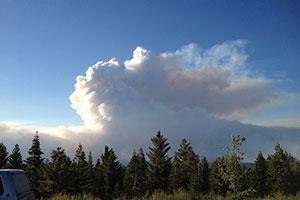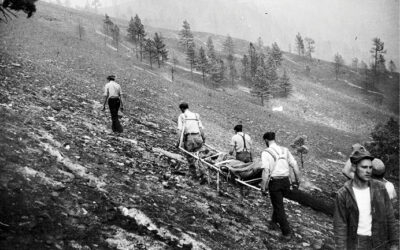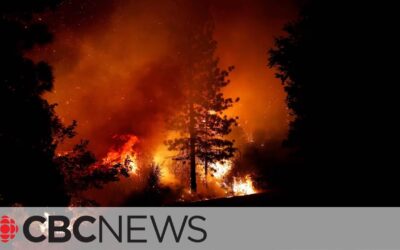Strategies for effectively applying intelligent aggression

The time-temperature curve has without question been changed in the structural fire environment, and it has done the same thing in the wildland fire environment. (Photo by author.)
By Todd McNeal
From the August 2016 Issue of FireRescue
With no shortage of press coverage on the historic drought conditions in the West, most wildland firefighters with potential to respond know the dire situation. The potential for large fire growth has never been higher and the hazards to personnel never greater. I want every person reading this to contemplate and let fully cement in their minds that fire suppression personnel are stepping off the apparatus into the most dangerous wildland fuel conditions in modern history.
Several factors have come together at this point in our nation’s history to produce the current condition of the fuel bed. It has taken more than a century to accumulate the level of fuels we now see in the wildland, and adding to that dangerous mixture our society has built homes and critical supporting infrastructure in and around this fuel, making numerous values at risk. This condition demands our highest level of critical thinking and appropriate risk management decisions. We have to continue to be aggressive in our tactics, but it has to be intelligent aggression-surgical placement of appropriate action to maximize safe effectiveness.
Information to Intelligence
There are several components that must be diligently followed to apply intelligent aggression, but the core foundation to that goal is to rapidly and accurately gather raw data or information and convert it to intelligence in the time-compressed wildland incident management response.
One of the most critical pieces of this intelligence that becomes part of our situational awareness is the concept of wildland fire in the third dimension. This is not a new concept in the study and practice of wildland fire suppression but needs to be reflected on and thoroughly understood now more than ever because of the level of potential the modern fire environment has reached. The challenge of this fact for all responders is we have limited options and minimal positive effect when fire expands into the third dimension. Fire in the third dimension can be succinctly explained as fire leaving the surface fuel bed and climbing the ladder fuel bed to involve the aerial fuel bed, all burning simultaneously.
There are many inherent risks to firefighters when this third-dimensional fire growth occurs. Three of the most critical to track and keep updated in one’s dynamic situational awareness while at a wildland fire incident include the following:
- Third-dimensional fire produces maximum British thermal unit (BTU) output in all fuel models because there is complete fire involvement throughout the vertical profile.
- Third-dimensional fire produces logic-defying rates of spread because of full availability of the fuel profile to the local and general wind, and that intensity is increased significantly by the in-draft winds flowing horizontally to replace the lifting heated air.
- Third-dimensional fire produces greater spotting distances because of large column growth and its ability to loft heavier and larger heat-holding particles landing miles away in a receptive fuel profile.
Recognition and Avoidance
The interactions of fuels, weather, and topography that combine on any given day at any given location are dynamic and immensely complex. There is no way for any firefighter to stop the process of fire exploding into the third dimension when fire environment ingredients are in alignment. The only mitigating factors that can be employed by firefighters when the fire explodes into the third dimension are recognition and avoidance of the path the fire chooses to travel during the event. I purposefully and intentionally use the word “explode†because that is what is occurring at the wildland fire incidents in current times and evidenced with the fires of the 2015 season.
Fires that escape initial attack are exploding into the third dimension quicker than in years past because of the prolonged record-setting Western drought. In addition to the critically low live and dead fuel moistures in the West, the drought has had a decimating effect on the timber stands. The three years and running tree mortality event in California is literally changing the face of the forests. Trees that haven’t succumbed to the lack of moisture have been killed by the bark beetle population expansion. The numerous forest pests are taking advantage of the weakened forest stands by capitalizing on the trees’ inability to defend themselves from attack. The net outcome of this ongoing event is the fact that the forest is filled with red needle trees, and all of these are like giant catcher’s mitts for the ember cast coming off the third-dimensional fire growth.
Accelerated Growth
This tree mortality event has many implications for responding firefighters. The list is truly too long to completely address in a single article, so I will elaborate on one of the most dangerous. I want to compel all firefighters, supervisors, and those making risk-benefit decisions to consider the idea that conditions in the timber fuel models have reached a condition that has never been experienced by past generations of wildland firefighters. The volume of accumulation, the lack of moisture, and tree mortality have created a fire environment that has time-compressed wildland fire progression to a point that few, if any, models can accurately predict. The potential for third-dimensional fire growth is very real, and firefighters need to be fully aware of that potential. I would like all resources, regardless of location, to reflect on the fact that the tree mortality has reduced the time of wildland fire growing into the third dimension dramatically!
Previous to the drought/infestation timber mortality event, fires needed to start in the surface fuels, grow to involve the ladder fuels, and then finally reach the aerial fuels, producing an ember shower that spots out in front of the main fire by landing on surface fuels and starting the growth process again. That takes some time to build, depending on environmental factors and location. Now, I would argue that that sequence has been considerably shortened or even eliminated because of current fuel conditions.
Now the fire starts its growth from surface to aerial and embers are produced, but they land in a receptive, expansive fine dead fuel model of red needles and the tree torches immediately without even needing the surface/ladder fuels to cure the canopy. Previously, the embers that would be intercepted by the canopy were landing in a largely healthy green canopy, and those embers rarely had enough heat to cause the tree to torch alone. Now, however, the embers land in a dead and dry receptive aerial fuel, fully unshaded and unsheltered to the sun and wind, and the growth is explosive.
The time-temperature curve has without question been changed in the structural fire environment, and it has done the same thing in the wildland fire environment. I would like to leave readers with a thought that I would encourage them to personally reflect on and share with their crews. As a wildland firefighter responding to an incident in the timber fuel models located in central/southern California forests, when you step off your apparatus to engage in fire suppression, you are stepping on top of a surface fuel model that is receptive, but you must not forget you also have a receptive fuel bed above you! Remember: Fire has the potential to explode into the third dimension quicker, spot farther, and run faster than ever before.
Todd McNeal
Todd McNeal is a 23-year veteran of the fire service and chief of Twain Harte Fire in Tuolumne County, California. He has a diverse background in wildland and structural fire management and suppression and has been serving as a division/group supervisor on a Federal Type II Incident Management Team for 10 years. McNeal has been an instructor in the fire service for 15 years, holds numerous ICS qualifications in wildland operations, is a registered instructor with California State Fire Training and a California fire officer, and has a bachelor’s degree in natural resource management. Read Full Bio




